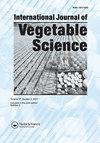不同果实颜色和形状甜椒杂交的质、量性状遗传控制
IF 1.1
Q2 Agricultural and Biological Sciences
引用次数: 1
摘要
由于缺乏足够的生理成熟期果实理化特性遗传控制信息,辣椒果实颜色和形状的遗传改良受到了限制。研究了由4个不同果色和果形的亲本杂交产生的6个遗传群体(P1、P2、F1、F2、BC1P1、BC2P2)在生理成熟期果实颜色和形状的遗传模式以及数量性状的基因作用性质。双隐性上位性基因作用参与了红×黄杂交果实颜色的表达。红×紫和红×白杂交的分离模式分别显示显性和隐性上位性。Blocky×Elongate杂交的果形分离表明隐性上位性基因相互作用。遗传模式表明,甜椒果实的颜色和形状受显性或隐性上位作用的两个基因的制约。试验杂交的分离模式显示有两个基因座参与;这两个基因座上的基因和它们的两个替代等位基因之间没有连锁。C/4×8/4和C/4×BCCAP Yellow组合中大多数数量性状的基因作用表明,非加性基因作用占优势,表现出重复上位性。果实的颜色和形状受显性或隐性上位作用的两个基因的制约,但这两个性状没有连锁。通过推进有前景的杂交组合,推迟选择可以改善果实的理化性状。本文章由计算机程序翻译,如有差异,请以英文原文为准。
Genetic control of qualitative and quantitative traits in bell pepper crosses involving varied fruit colors and shapes
ABSTRACT Genetic improvement of fruit color and shape of bell pepper (Capsicum annuum var. grossum Sendt.) have been constrained by lack of adequate information on genetic control of fruit physical-chemical characteristics at the physiologically mature stage. Inheritance pattern of fruit color and shape and the nature of gene action for quantitative traits at physiological maturity were studied in six genetic populations (P1, P2, F1, F2, BC1P1, BC2P2) generated from four crosses involving parents bearing different fruit color and shape. Duplicate recessive epistasis gene action was involved in the expression of fruit color in Red × Yellow cross. The segregation pattern of the crosses Red × Purple and Red × White indicated involvement of dominant and recessive epistasis, respectively. Fruit shape segregation of the cross Blocky × Elongate indicated recessive epistasis gene interaction. The inheritance pattern indicated that fruit color and shape in bell pepper were conditioned by two genes with either dominant or recessive epistatic action. The segregation pattern of test crosses revealed involvement of two loci; there is no linkage between the genes and their two alternative alleles on both the loci. Gene action of most of the quantitative characters in the crosses ‘C/4 × 8/4ʹ and ‘C/4 × BC CAP Yellow’ indicated predominance of non-additive gene action showing duplicate epistasis. Fruit color and shape were conditioned by two genes showing either dominant or recessive epistatic action, however, these two characters were not linked. Fruit physical and chemical traits could be improved following deferred selection through advancement of promising cross-combination.
求助全文
通过发布文献求助,成功后即可免费获取论文全文。
去求助
来源期刊

International Journal of Vegetable Science
Agricultural and Biological Sciences-Plant Science
CiteScore
3.10
自引率
0.00%
发文量
30
期刊介绍:
The International Journal of Vegetable Science features innovative articles on all aspects of vegetable production, including growth regulation, pest management, sustainable production, harvesting, handling, storage, shipping, and final consumption. Researchers, practitioners, and academics present current findings on new crops and protected culture as well as traditional crops, examine marketing trends in the commercial vegetable industry, and address vital issues of concern to breeders, production managers, and processors working in all continents where vegetables are grown.
 求助内容:
求助内容: 应助结果提醒方式:
应助结果提醒方式:


